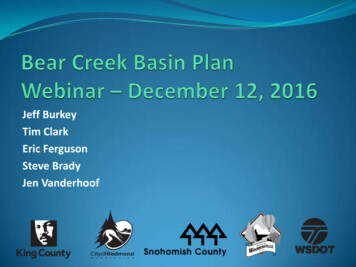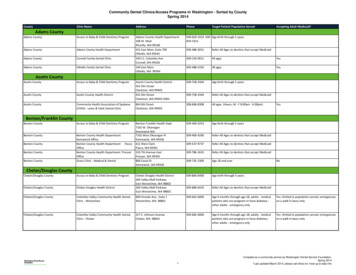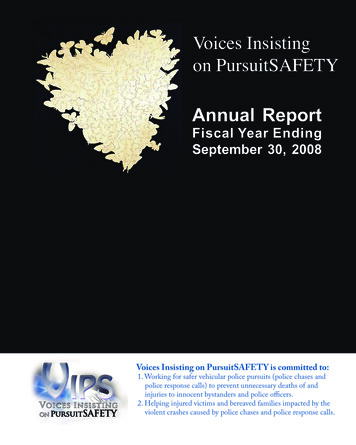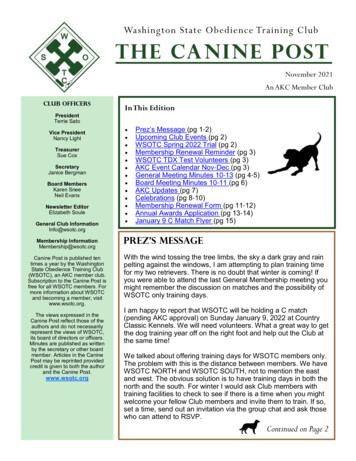
Transcription
Jeff BurkeyTim ClarkEric FergusonSteve BradyJen Vanderhoof
Webinar Outline Welcome & Introductions Overall Project Update – Jeff Burkey Project Reports Water Quality – Tim Clark BIBI – Steven Brady Wetland Vegetation – Jen Vanderhoof Riparian Vegetation – Jen Vanderhoof Summary and Next steps - Jeff Burkey
Overall Project UpdateMilestones Form Partnerships Storm Monitoring Mapping Model Development(December 2016)Existing ConditionsAssessment(December 2016)Stormwater ManagementStrategies and DraftImplementation Plan(June 2017)Final Watershed Plan(April 2018)
Tim ClarkEric FergusonBear Creek Technical WebinarDecember 12, 2016Department of Natural Resources and ParksWater and Land Resources Division
Long-term Monitoring in Bear Creek King County has monitored the Bear Creek watershed aspart of its Stream and River Monitoring Program since the1970s. Nutrients Fecal coliform bacteria Temperature, dissolved oxygen, pH, conductance Metals and organic compounds sampled as part ofspecific projects Evans Creek and lower Bear Creek sites included inhistoric trend analysis to detect changes across thewatershed.
Bear Creek Watershed Bear/Evans/Cottage Lake Creeks areapproximately 31,200 acres 5 sites used for long-term waterquality 6 sites used for continuoustemperature dataLegendLong-term water quality sitesContinuous temperature sitesArea outside Basin Plan study areaLocal jurisdictions
CurrentConditions 13 sites monitored forWater Quality– 6 Base Flow, 6 Storm Events– March 2015 – January 2016 Parameters Analyzedinclude:––––––Dissolved Oxygen,TemperatureTotal Suspended SolidsDissolved Zinc, CopperFecal BacteriaNitrogen
Trend Results Bacteria is improving(90% decline at 0484from 1975 – 2015)- Temperature isincreasing (0.3 to 0.6 C per decade)- Dissolved oxygen isdecreasing (0.1 to 1mg/L per decade)- Big decrease atEvans Creek Nutrients aredecreasing (1993 forward)AmmoniaNitrate NitriteBear Creek@Redmond(0484)Bear Creek@ 95th AveBridge(C484)Bear Creek@ 133rd AveBridge(J484)CottageLake Creek@ ToltPipeline(N484)EvansCreek @Union HillRd (B484) - -
Nutrients are decreasing over time Phosphorus at all sites(30 to 60%) Nitrogen at some sites 70% NO3 at Evans 61% NH4 at Bearmouth
Fecal coliforms have decreasedbut still above standard2015/2016Bacteria RangeArea-Wide
Temperature and DO getting worseIncreased frequency andmagnitude of statestandards violations fortemperatureIncreased frequency andmagnitude of statestandard violations fordissolved oxygen11
Current Conditions
High ConcernModerate ConcernLow ConcernTemperature Violated state standardsthroughout watershed in 2016.
WQ – DissolvedOxygen Of concern throughoutwatershedDO - minimum vale (mg/L)121089.5 Standardbase6420storm
WQ – FecalColiform Storm data over limit Only 2 sites have high baseFC data Monticello Cr Lower Bear CrFC-geo-base6005004003002001000FC-geo-storm
WQ – TSS 5 sites with high TSS 2 low TSS (base & storm) 3 sites base storm
Mackey CrWQ – metalsCold Cr Copper concentrationsexceeded state standards at2 locations in 2015 stormmonitoring Cold Cr Mackey Cr Metal concentrations werebelow state water qualitystandards thru 201417
What’s Driving Long-term Trends? Why is water quality improving? (nutrients, fecals) Land use change? (agriculture - suburbs/forest) Bacteria TMDL? Stream stewardship? (livestock exclusion) Land use regulations? Probably all of the above Why is temperature and dissolved oxygen getting worse? Riparian deforestation? Decreased cool, groundwater input? Increased organic matter loading from wetlands in Evans Creek?
Urbanization over Time19
Conclusions Some water quality improvement, some water qualitydegradation. Basin Plan can identify project solutions for decreasinghuman health risk (bacteria) and protecting aquatic life(temperature, dissolved oxygen, TSS).
Tim ingcounty.govEric w.kingcounty.gov
Steve BradyBear Creek Technical WebinarDecember 12, 2016Department of Natural Resources and ParksWater and Land Resources Division
Biotic Integrity“the ability to support and maintain a balanced,integrated, and adaptive community of organismshaving a species composition, diversity andfunctional organization comparable to those ofnatural habitats within a region” Karr, 1981
Benthic MacroinvertebratesRepresent Integrated Response
Invertebrates sensitive tocontaminantsMcIntyre et al. 2015 Chemosphere
Invertebrates also sensitive to Instream habitat conditions, especially fines Changes in food (leaf litter vs algae) Pesticides, especially insecticides Non-native plant and animal species Fragmented land cover, no pathways for dispersal Most of which can be associated with urbanization
Urbanization Diminishes Diversity
Benthic Index of Biotic Integrity (B-IBI)10 Metrics in the B-IBI Pollution tolerance/ intoleranceTaxonomic compositionPopulation attributesFeeding and habits
B-IBI Condition Categories
Data sourced from PSSBMany partnerscollected data
B-IBI has Broader Relevance & ContextPuget Sound PartnershipVital Sign IndicatorSupports NPDESPermitting
B-IBI Increasing Over TimeStatewide ( ) and Study area ( ) ½ point per year increase
Urbanization degrades B-IBIStatewide ( ) and study area ( ) Strong negative effect High variation (e.g.undeveloped sites can havelow scores) Annual variability
B-IBI Current Conditions
B-IBI is Dynamic
B-IBI is Dynamic39
Urban Areas Increased in Study Area
Increased Urban Cover in Study Area
Urbanization Increases Flashiness
Flashiness Degrades B-IBI
B-IBI Improved in Some Sites
B-IBI Stable/Deteriorated in Others
Summary Slight increase in B-IBI statewide over 20 years But still not at desired levels B-IBI strongly influence byurbanization Many sites in Study Area have declining B-IBI Flashiness increases with urbanization and deteriorates BIBI Reducing flashiness may contribute to improved B-IBI inthe future
Steve ngcounty.gov
Jen VanderhoofBear Creek Technical WebinarDecember 12, 2016Department of Natural Resources and ParksWater and Land Resources Division
The importance of wetlandsWetlands perform a wide array of ecological functionsand environmental benefits: water purification flood protection groundwater recharge streamflow maintenance valuable habitat for fish and wildlifeImportant part ofwatershedhydrology
Objectives of the wetland assessment Report on current conditions. Estimate change in wetland presence over thepast 25-35 years.
Determining current conditions Must rely on GIS data for wetland assessment Available data: King County Wetland Inventory; 1981; 1990 National Wetland Inventory; 1983-84 King County permit application data (“CAO” wetlands);2005-13 Snohomish County; 2011 City of Woodinville; 2006-2007 plus other City of Redmond No wetland datasets are complete or fully accurate
Multiple datasets complicateinventory All overlapping wetlandswere merged to simplifythe analysis
Resultsof data merge Approx. 330 mapped wetlands 90 in Sno Co & 240 in King Co 1693 acres total Wetland identification errors: Likely many more wetlands in thewatershed that are not mapped(errors of omission). Not all mapped wetlands have beenverified to actually be wetlands(errors of commission).
Losing wetlands?Original year of KCWIwetlands field checking Need reliable data forchange analysis Subset of 54 KCWI wetlandsselected for use as baseline: original presence fieldverified not delineated inventory built over severalyears
Change analysisPhoto date:19891990 survey: 87 acres2015 Visual then-and-now comparisons All developedareas cut out oforiginal polygon Undevelopedacreage may ormay not bewetland2015 aerial: 60.3 acres
Results: 2015 compared to baselineObservable change from aerial photos: 20% (11 out of 54) of baseline wetlands were visiblyaltered since 1981-1990. 9 of the 11 wetlands with loss were intact in 1990,when the SAO was passed. This subset shows loss to mapped wetlands over past 35 years.56
Errors of omissionOf the 68 “CAO wetlands” currently in the watershed inGIS: 31% (21 out of 68) overlap KCWI or NWI wetlands. 47 (69%) do not and are not in immediate vicinity. These previously undetected wetlands tend to be small or forested. Results suggest there are unmapped small or forested wetlands.Gone without a trace: It’s possible/likely that prior toregulations in 1990 that many unmapped wetlandswere filled.
Urbanization & wetlands19791990
Wetlands Analysis Summary Wetlands are important because of their role inthe watershed’s hydrology & ecology Approx. 330 mapped wetlands in watershed &likely many more unmapped wetlands Change analysis shows loss to development 20% of baseline wetlands were visibly altered since1981-1990 Limitations of available data likely leads to under-reporting of loss
Jen ty.govwww.kingcounty.gov
Jen VanderhoofBear Creek Technical WebinarDecember 12, 2016Department of Natural Resources and ParksWater and Land Resources Division
The importance of riparian areasHealthy riparian areas, defined as beingvegetated in native trees and shrubs, areimportant because they: improve water quality by helping filter pollutants reduce stream bank erosionImportant partof watershedhydrology increase shade, which lowers water temperatures,which in turn support the higher dissolved oxygenlevels provide a source of large wood to the streams,which increases instream habitat complexity provide over-hanging vegetation, which creates asource of invertebrates to the streamsBenefitsalmon &systemecology
Objectives of this riparian assessment Report on current conditions. Examine changes in riparian land cover over time.
How wide a corridor to study?Regulatory context (each defined by jurisdiction) Critical Areas: stream riparian buffers 165 ft in King Co. 150 ft in Snohomish Co. Shoreline Management jurisdiction Minimum of 200 feet from OHWM of streams mean annual flow of 20 cfs Shorelines of statewide significance 400 ft corridor selected to study –200 ft on each side of stream center-line
Which streams?Stream extent in study area: 65.6 total stream miles 46.7 miles of streamwith confirmed orpotential salmonpresence
Need good data External (non-King County) landcover datasets: National Land Cover Database(NLCD; full basin coverage). Coastal Change Analysis Program –2011 (CCAP; full basin coverage). WDFW draft data – 2011 and 2013(missing portions of the northernbasin).WrongscaleToomucherror
Good data!New dataset: WDFW data as foundationfor: Forest Impervious Drew in: ShrubPastureNon-forested WetlandWaterPossible Beaver DamOther Hand-corrected on multiplepasses
Current riparianland cover400-ft corridor results* Other: lawn/yard/landscaping,bare area, certain gravel surfaces,mud, and mowed roadside.
Slice and diceThe 400-ft wide corridorcan be clipped – toestimate areas relevant toregulations, for example.
Land cover in 165-ft buffer
Invasive species Cleared to edge/no shade Publicly ownedAcres Chinook watersAttributes
Missing photos: Pre-settlement mid-1800s old-growth Post-logging early 1900sHistory offorest change193619722002201580-year progression of photos at NE 146th Way & 186th Place NE
1972 aerial imagery poorresolution need broadcategories of land cover.1972Limited data forchange analysis20151972 gross-level land cover digitization versus fine-scale 2015 .
1972 land cover1972400-ft corridor results
Changes over past 43 years From a time of reforested conditions to now: Forest and native shrub combined decreasedfrom 69% to 58% Disturbed area (not including pasture) increasedfrom 14% to 27%
Urbanization & riparian land cover197219902005
Riparian Assessment Summary Riparian areas are important because of their role inthe watershed’s hydrology & ecology Currently a 165-ft wetland buffer in the riparian studyarea includes: 47% trees (of varying age, species, function) 6% impervious surface 19% shrub Change analysis shows 22% less riparian trees thanin 1972, when development was beginning to climb
Jen ty.govwww.kingcounty.gov
Jeff BurkeyBear Creek Technical WebinarDecember 12, 2016Department of Natural Resources and ParksWater and Land Resources Division
Summary and Next Steps
Partners King County City of Redmond Snohomish County City of Woodinville WA Dept. of Transportation
Jeff ngcounty.gov
Model Development (December 2016) Existing Conditions Assessment (December 2016) Stormwater Management Strategies and Draft . Change analysis shows 22% less riparian trees than in 1972, when development was beginning to climb Riparian Assessment Summary .










